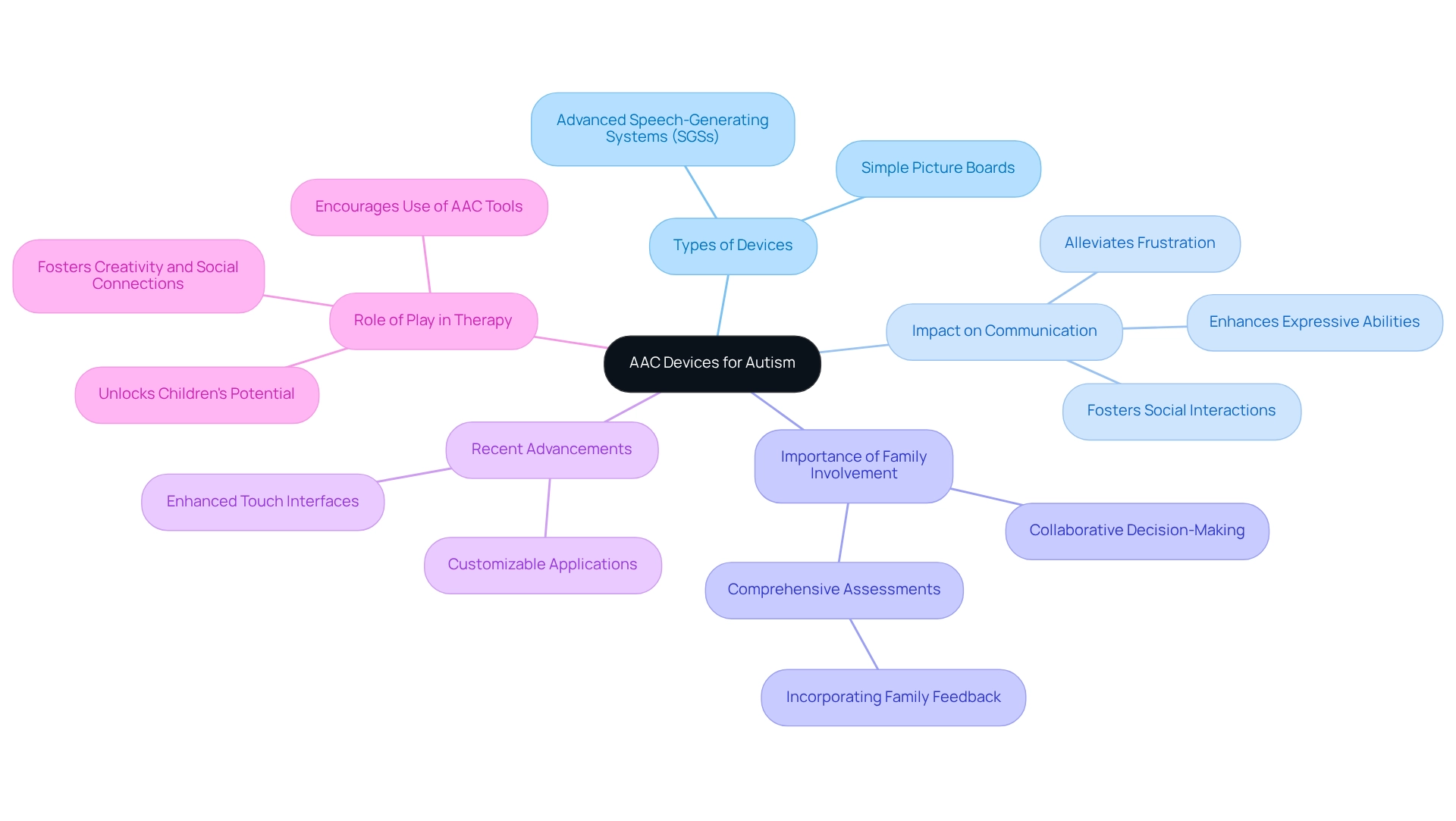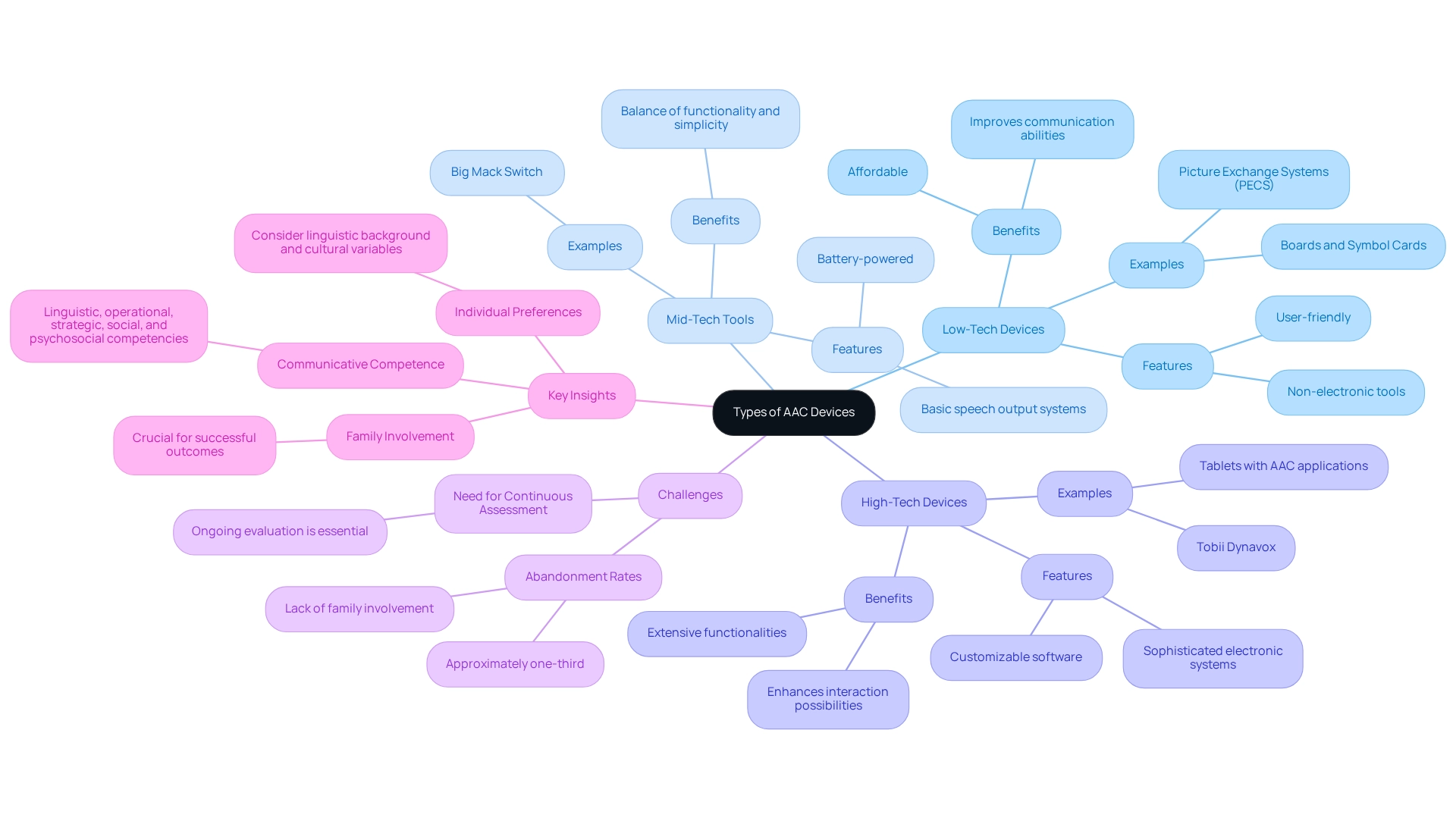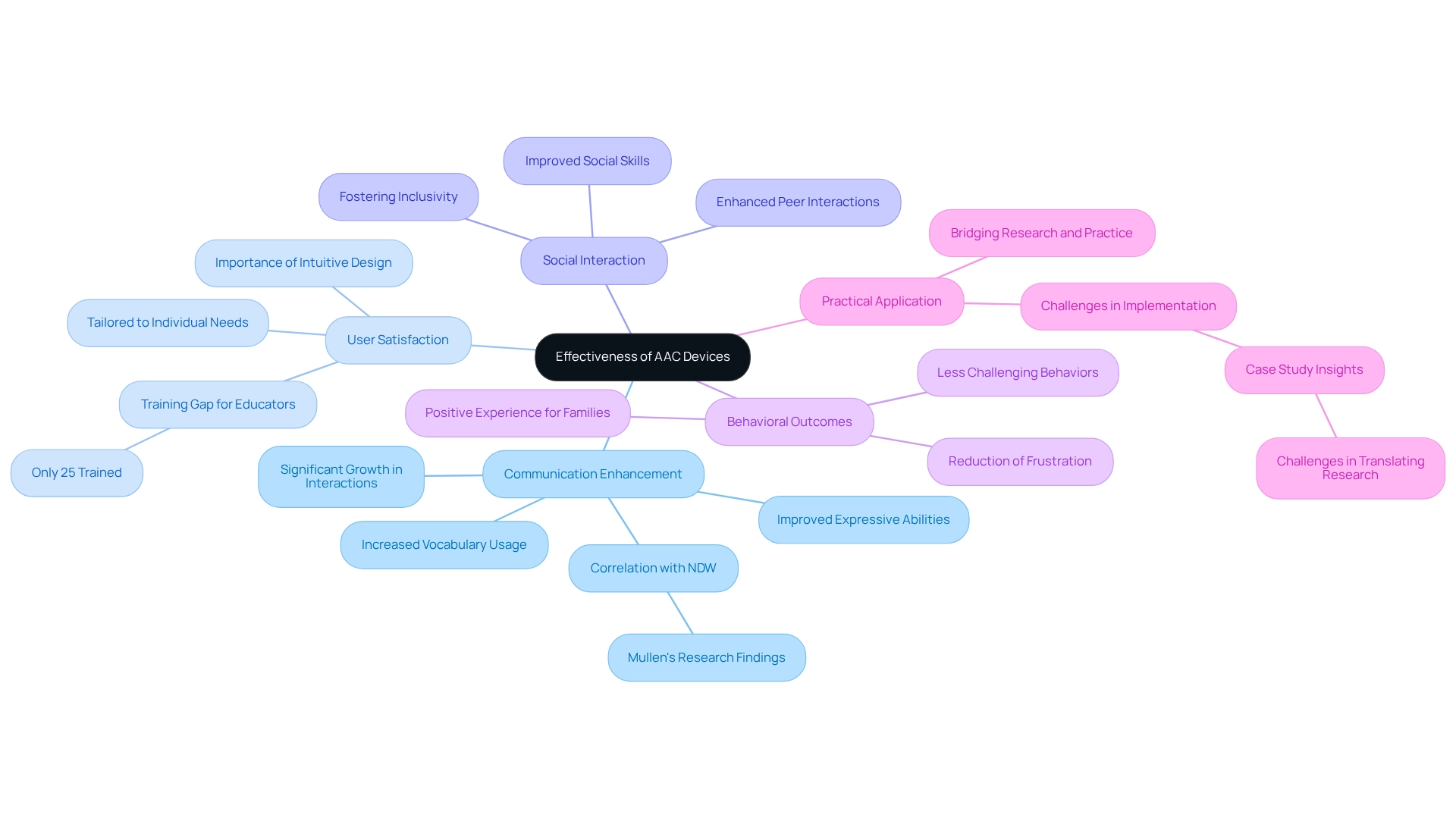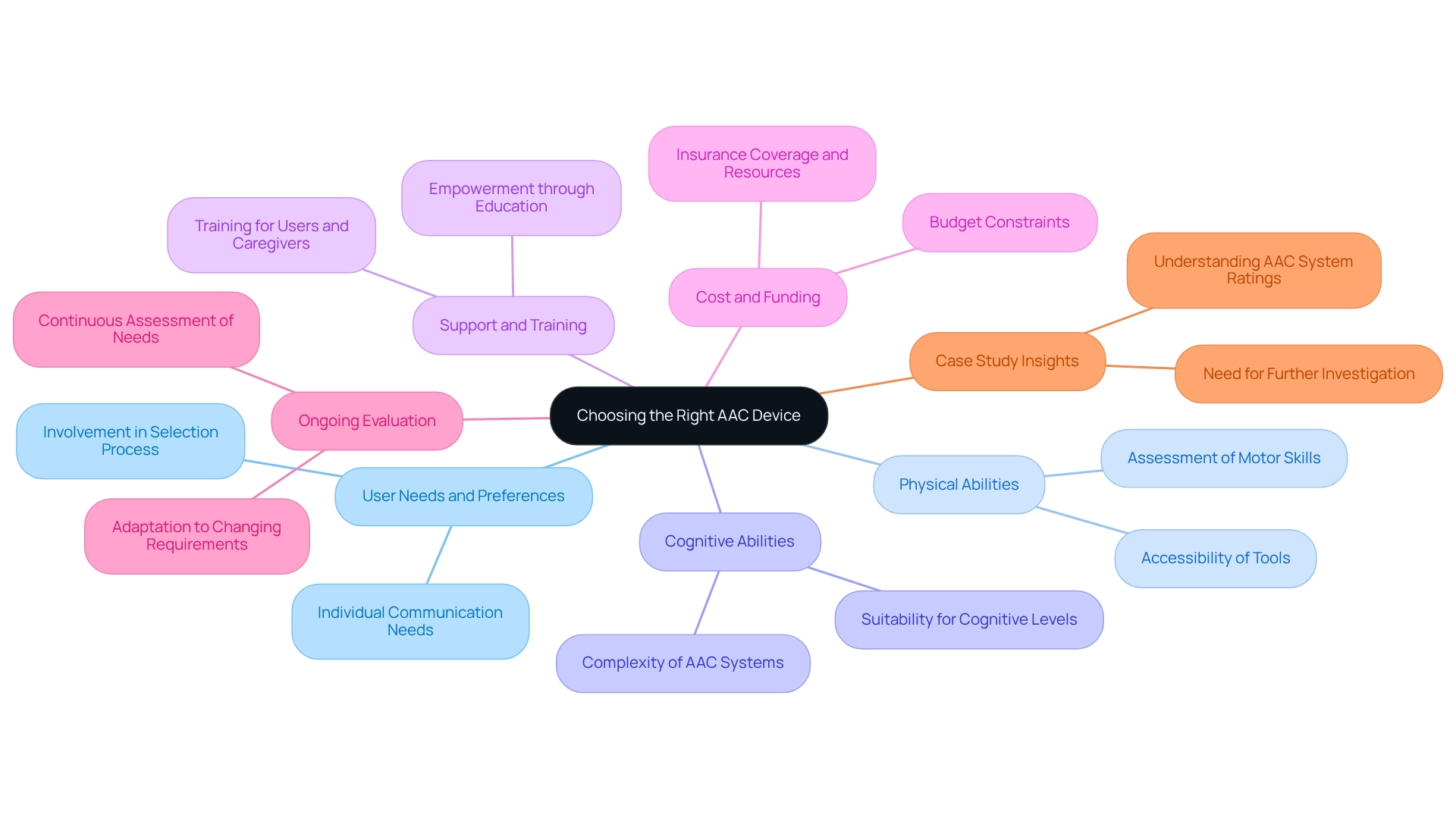Overview
This article delves into the vital comparison of various speech devices designed for individuals with autism, particularly focusing on their types and effectiveness in enhancing communication for those with autism spectrum disorder (ASD). Understanding the significance of selecting the right augmentative and alternative communication (AAC) devices is crucial. These devices range from low-tech to high-tech options, and the selection process must be tailored to meet individual needs and preferences.
Moreover, the involvement of family members in this decision-making journey plays a significant role. When families are engaged, it not only influences user satisfaction but also helps to reduce abandonment rates of these devices. This highlights the importance of collaboration and support in ensuring that individuals with ASD have the tools they need to communicate effectively.
As you explore the options available, consider how each device aligns with your loved one's unique requirements. Sharing experiences and seeking guidance can be incredibly beneficial. We encourage you to reach out, share your thoughts, and connect with others who understand this journey. Together, we can foster an environment where every individual with autism has the opportunity to express themselves fully.
Introduction
In a world where communication is vital, individuals with autism spectrum disorder (ASD) often face significant challenges in expressing themselves. This can be a source of frustration and isolation for both them and their families. Augmentative and Alternative Communication (AAC) devices have emerged as transformative tools, bridging the gap between thought and expression. From simple picture boards to sophisticated speech-generating devices, these technologies are designed to empower users, enhance their quality of life, and foster meaningful interactions. Imagine the joy of a child finally being able to share their thoughts and feelings with their loved ones.
However, the journey to selecting the right AAC device is complex, requiring careful consideration of the user’s unique needs, preferences, and abilities. It's essential to understand that what works for one individual may not work for another. As advancements in AAC technology continue to evolve, understanding the diverse options available and their effectiveness is crucial for families and professionals alike. This knowledge can make a significant difference in the lives of those affected by ASD.
This article delves into the intricacies of AAC devices, exploring their impact, types, effectiveness, and essential factors to consider when choosing the most suitable option for individuals with autism. By the end, we hope to provide you with valuable insights and resources that can help navigate this important decision.
Understanding AAC Devices for Autism
A speech device for autism serves as a vital resource for individuals facing interaction challenges, particularly those with autism spectrum disorder (ASD). These tools vary widely, from simple picture boards to advanced speech-generating systems (SGSs), each designed to facilitate alternative means of communication. Research indicates that around one-third of AAC systems are abandoned, highlighting the urgent need for ongoing collaborative decision-making and comprehensive assessments that involve family input during the selection process. This approach not only ensures effective usage but also reduces abandonment rates.
The impact of AAC on expressive abilities is profound. It empowers individuals to articulate their thoughts, needs, and emotions, significantly enhancing their quality of life. By fostering social interactions and alleviating frustration linked to communication barriers, a speech device for autism allows individuals with autism to engage more fully in their environments.
Recent advancements in AAC technology in 2025 have introduced more intuitive and user-friendly options, including a speech device for autism, such as enhanced touch interfaces and customizable applications, making communication more accessible. For instance, case studies reveal that thorough AAC evaluations, which incorporate family feedback, lead to better equipment selection and ongoing support, ultimately improving interaction outcomes.
Moreover, the role of play in therapy is crucial, as it unlocks children's potential and encourages the use of AAC tools in natural settings. Engaging in play not only enhances interaction skills but also fosters creativity and social connections. Real-world examples demonstrate how these tools have transformed communication for many individuals, allowing them to express themselves and connect with others in meaningful ways. As Billy T. Ogletree aptly states, "AAC instruments are not just tools; they are bridges to understanding and connection."
In summary, understanding the various types of AAC tools and their functionalities is essential for selecting the most suitable option tailored to each person's unique needs. A structured examination of the benefits and drawbacks of AAC tools can further aid in this selection process, empowering families to make informed choices that best support their loved ones.

Types of AAC Devices: Low-Tech, Mid-Tech, and High-Tech
AAC devices include a speech device for autism, which comes in three main types, each offering unique features and benefits that can significantly impact communication for individuals with diverse needs.
- Low-Tech Devices: These non-electronic tools, such as picture exchange systems (PECS), boards, and symbol cards, are often more affordable and user-friendly. They can be particularly beneficial for individuals who may feel overwhelmed by technology. Research shows that low-tech AAC tools can greatly improve communication abilities, with many individuals reporting enhanced interactions with peers and caregivers.
- Mid-Tech Tools: Typically battery-powered, mid-tech tools consist of basic speech output systems that enable individuals to record and replay messages. A familiar example is the Big Mack switch, which activates a recorded message when pressed. These devices strike a balance between functionality and simplicity, making them suitable for those who need more than basic options but may not require the complexity of advanced technology.
- High-Tech Devices: These sophisticated electronic systems can generate speech and often feature customizable software. Examples include tablets equipped with AAC applications and specialized speech-generating tools like the Tobii Dynavox. High-tech devices provide extensive functionalities, including voice output, text-to-speech features, and interconnectivity with other technologies, thus expanding interaction possibilities for users.
While each speech device for autism type presents unique advantages, they also come with challenges. For instance, abandonment rates for AAC systems can reach approximately one-third, often due to a lack of family involvement in the selection and implementation process. Involving family members in the AAC journey is essential for promoting successful interaction outcomes and decreasing abandonment rates. As highlighted in the case study "Family Involvement in AAC Processes," including family members in the AAC process is crucial for achieving effective communication results.
Continuous assessment and decision-making remain vital, even after choosing a speech device for autism, to ensure it continues to meet the individual's evolving needs. Furthermore, expert perspectives indicate that although low-tech solutions fulfill essential roles, mid-tech and high-tech tools can offer advanced features tailored for specific disabilities, enhancing experiences for individuals. As Amy M. Sonntag observes regarding the Participation Model for Augmentative and Alternative Communication, participant involvement is key in the selection process.
Understanding the effectiveness of these tools is paramount. The case study titled "Communication Competence in AAC Users" emphasizes that communicative competence for AAC users encompasses linguistic, operational, strategic, social, and psychosocial competencies necessary for effective communication. Therefore, careful consideration of individual preferences, abilities, and unique characteristics, including linguistic background and cultural variables, is essential when selecting a speech device for autism as an AAC tool.

Evaluating the Effectiveness of AAC Devices in Communication
The effectiveness of AAC devices can be evaluated through several key metrics that truly matter to families and caregivers.
- Communication Enhancement: Imagine the joy of seeing your child express themselves more clearly. Studies show that AAC tools greatly improve both expressive and receptive interaction abilities. For instance, children using speech-generating devices (SGDs) often demonstrate significant growth in vocabulary usage and unprompted interactions, leading to more meaningful exchanges. Mullen's research highlights that metrics like the number of different words (NDW) positively correlate with communication outcomes, underscoring the importance of effective AAC implementation.
- User Satisfaction: Your feedback is essential in assessing how well AAC devices work. Devices that are intuitive and tailored to individual needs typically yield higher satisfaction rates among users and their caregivers. However, it's concerning that only 25% of educators reported receiving instruction on SGDs, which may create a gap that affects both experience and satisfaction.
- Social Interaction: Effective AAC tools can open doors to greater social engagement, allowing users to participate more actively in conversations and social settings. Studies reveal that children using these devices often experience enhanced peer interactions and improved social skills, fostering a more inclusive environment that benefits everyone.
- Behavioral Outcomes: One of the most crucial indicators of AAC effectiveness is the reduction of frustration and challenging behaviors that can arise from communication difficulties. When individuals can express their needs and thoughts, they are less likely to exhibit behaviors stemming from interaction barriers, leading to a more positive overall experience for both the individual and their family.
The case study titled "Challenges in Translating Research to Clinical Practice" emphasizes the importance of connecting research outcomes with practical applications, ensuring that effective AAC tools are utilized in therapeutic settings.
In summary, an expanding collection of studies highlights the transformative potential of speech devices for autism in enhancing interaction for individuals with autism. It stresses the significance of user satisfaction and effective application in therapeutic environments. Together, we can advocate for better resources and support systems to ensure every child has the opportunity to communicate effectively.

Choosing the Right AAC Device: Key Considerations
Choosing the right AAC device is a journey filled with important considerations that can greatly impact communication.
- User Needs and Preferences: It all begins with understanding the individual’s unique communication needs, preferences, and comfort with technology. As O. Ivar Lovaas wisely noted, "If they can't learn the way we teach, we teach the way they learn." This highlights the importance of tailoring the selection process to fit the individual. By involving individuals in this journey, we often see better outcomes, as their insights can significantly influence the choice of equipment.
- Physical Abilities: Next, we must assess the individual’s motor skills and physical capabilities. This step is crucial in identifying the most accessible tools. For example, those with limited mobility may find devices that require less physical interaction to be more suitable.
- Cognitive Abilities: The cognitive level of the individual should also guide the complexity of the AAC system. Simpler tools are often more appropriate for those facing cognitive challenges, while individuals with higher cognitive functioning might thrive with advanced options.
- Support and Training: Consider the availability of support and training for both users and caregivers. Comprehensive training can empower individuals to use their AAC tools effectively in daily communication, enhancing their overall experience.
- Cost and Funding: Financial factors cannot be overlooked. Budget constraints and funding options play a vital role in selecting AAC equipment. It’s important to explore insurance coverage and available funding resources to make well-informed decisions.
- Ongoing Evaluation: Remember, the process doesn’t end once an AAC system is chosen. Continuous evaluation and decision-making are essential to ensure the device meets the evolving needs of the individual.
- Case Study Insights: A study titled "Understanding AAC System Ratings" examined how AAC professionals rated various systems for children. The results showed that while many systems were deemed suitable, few were considered excellent, indicating a need for deeper exploration into decision-making processes and the characteristics that influence these ratings.
By thoughtfully considering these factors, parents and professionals can find an AAC device that truly meets the individual’s unique needs, ultimately enhancing their communication abilities. This thoughtful approach is reinforced by ongoing evaluations and research in the field, underscoring the importance of adapting to user needs and preferences. We invite you to share your experiences or seek support as you navigate this important decision.

Conclusion
The exploration of Augmentative and Alternative Communication (AAC) devices reveals their profound impact on individuals with autism spectrum disorder (ASD). These devices, ranging from low-tech options like picture boards to sophisticated high-tech speech-generating devices, serve as vital tools that empower users to express their thoughts, needs, and emotions. Family involvement in the selection process is crucial, as it significantly influences the effective use and acceptance of these systems. By prioritizing user preferences and conducting thorough assessments, families can ensure that the chosen AAC device enhances communication rather than becoming a source of frustration.
Research underscores that AAC devices not only improve communication skills but also foster social interactions and reduce feelings of isolation. With advancements in technology, these devices have become more intuitive and accessible, further empowering users to engage meaningfully with their surroundings. Evaluating the effectiveness of AAC devices involves considering communication improvement, user satisfaction, social interaction, and behavioral outcomes, all of which highlight the transformative potential of these tools.
Ultimately, selecting the right AAC device is a nuanced process that requires careful consideration of individual needs, physical and cognitive abilities, and ongoing support. By embracing a collaborative approach that includes input from users and families, the journey toward effective communication can be navigated successfully. AAC devices truly represent bridges to understanding and connection, opening up new avenues for individuals with ASD to share their voices with the world.
Frequently Asked Questions
What is a speech device for autism?
A speech device for autism is a vital resource designed to assist individuals with autism spectrum disorder (ASD) in overcoming interaction challenges. These devices range from simple picture boards to advanced speech-generating systems (SGSs) that facilitate alternative means of communication.
Why do some AAC systems get abandoned?
Research indicates that around one-third of augmentative and alternative communication (AAC) systems are abandoned. This highlights the need for ongoing collaborative decision-making and comprehensive assessments that involve family input during the selection process to ensure effective usage and reduce abandonment rates.
How does AAC impact expressive abilities?
AAC profoundly impacts expressive abilities by empowering individuals to articulate their thoughts, needs, and emotions, which significantly enhances their quality of life. It fosters social interactions and alleviates frustration linked to communication barriers, allowing individuals with autism to engage more fully in their environments.
What advancements have been made in AAC technology recently?
Recent advancements in AAC technology have introduced more intuitive and user-friendly options, such as enhanced touch interfaces and customizable applications, making communication more accessible for individuals with autism.
How important is family involvement in the AAC selection process?
Family involvement is crucial in the AAC selection process. Thorough evaluations that incorporate family feedback lead to better equipment selection and ongoing support, ultimately improving interaction outcomes for individuals using AAC.
What role does play have in the use of AAC tools?
Play plays a vital role in therapy as it unlocks children's potential and encourages the use of AAC tools in natural settings. Engaging in play enhances interaction skills, fosters creativity, and helps build social connections.
What should families consider when selecting AAC tools?
Families should understand the various types of AAC tools and their functionalities to select the most suitable option tailored to each person's unique needs. A structured examination of the benefits and drawbacks of AAC tools can further aid in making informed choices that best support their loved ones.




